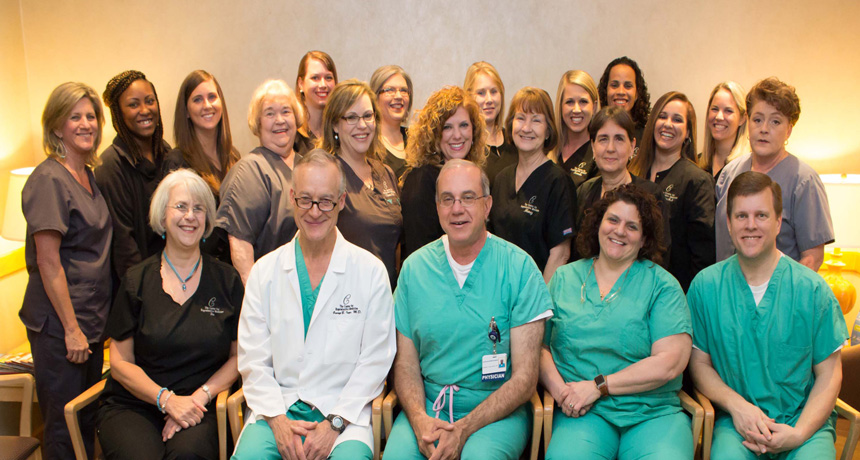We discuss common reasons why a woman will need a tubal reversal and what to expect with a tubal reversal surgery.
Women generally have two choices for undergoing a tubal reversal procedure:
- Heavily marketed tubal reversal centers that are not affiliated with hospitals
- Reproduction medicine clinics that can provide the benefits of a hospital operating room, co-primary fertility micro-surgeons working as a team, overnight hospital care following surgery and other services, including in-vitro fertilization (IVF), that can maximize success (a healthy baby) and avoid complications
This brief description of The Center’s tubal reversal services provides facts that can help couples make the best choice as they select a provider for tubal reversal.
Early Identification of Male Factor Infertility Issues
At The Center, the sperm analysis is checked to identify low sperm counts that could require In Vitro Fertilization (IVF). This is an important step for patients and is done early in the process because when males have low sperm counts the tubal reversal may not be the only problem preventing conception. IVF treatments can help many of these families. If IVF is used the cost, time and discomfort of a tubal reversal are not needed to become pregnant.
Preparing for Tubal Reversal Surgery
At The Center, evaluation begins with a detailed discussion between the fertility specialist and the patient, and whenever possible, her husband. The woman’s medical history is reviewed and a complete physical exam is performed to make sure she is a good candidate for successful surgery. An x-ray of the uterus and tubes is done when needed to evaluate uterine abnormalities and determine the length of the inner ends of the tubes available for reversal.
The patient’s medical records are obtained and reviewed to determine their type of tubal ligation and presence or absence of other gynecologic disease. A Fallope-ring, Hulka clip, filshe clip or Pomeroy type postpartum tubal ligation destroys the smallest amount of tube. They are the easiest to reverse. The electro coagulation type (burning) may destroy a large portion of the tube and prevent reversal. This is especially true if three areas of burn are performed on each tube. Usually ligations that are only burned in one area per side can be reversed, otherwise IVF fertilization is required for conception.
Tubal Reversal Surgery
The Center’s surgeons use a hospital operating room with full anesthesia coverage and specialized operating microscope suspended over the operative field. The Zeiss microscope is the same double-eyepiece instrument used for neurosurgery and eye surgery. It provides magnification from six to twenty times actual size. Some reversal centers rely on loops or magnification glasses with only 4 to 6 power.
High magnification is important because tubes are tiny, 0.5mm to 4 mm in diameter. The Center’s surgeons use specialized instruments to provide the precision required for infertility microsurgery. The Center’s fertility surgeons — Dr. George Koulianos and Dr. George Inge — operate together as a team of primary surgeons. They are assisted by specially trained nurses. The co-surgeon approach allows the surgeons to avoid fatigue and discuss their surgical strategy as the microsurgery is performed. Many reversal clinics use only one primary surgeon.
A small abdominal incision is made about 3 to 4 inches long. The needles and sutures are so small about 4 mm they are very difficult to see without the Zeiss microscope. Special microelectrodes are used to control bleeding. Continuous bathing of tissues with physiologic solutions aid in prevention of tubal damage or scare tissue by keeping the tubes moist at all times.
The blocked ends of the tubes are removed and the tubes reconnected. The inside diameter of the tube may be no larger than .5 mm (2/100ths of an inch). At least four stitches are usually placed in the tube followed by a running stitch in the outer layer.
The Center’s patients are usually discharged to home the morning following this surgery; however, patients can be discharged the same day if they wish and are stable. Complications with this type of surgery are unusual but as with any operation, can occur. Many reversal centers do not provide overnight hospital care and patients who become nauseous or have other complications and need hospitalization have to go by ambulance through the hospital admitting process. Women with major medical problems or who are morbidly obese or over 44 years of age are generally not candidates for this type of surgery.
Chances of Having a Baby with Tubal Reversals
The best chance of a successful tubal reversal is the first operation. Redoing tubal reversals has poor outcomes for conceiving.














